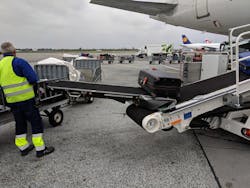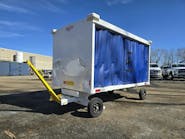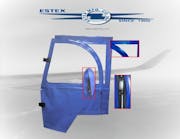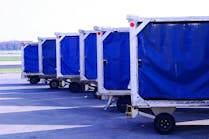Work performed on airport ramps around the world can be difficult and physically taxing. In order to keep ground handlers from suffering injuries, the GSE industry is constantly evolving and creating new equipment to keep users safe.
Power Stow and Telair International, along with partners Swissport and AUXIVO are among those advancing GSE designed to protect the people who repeatedly load and unload baggage.
Help Loading the Aircraft
Qantas Airlines was in search of an aid to load and unload their aircraft in combination with their on-board sliding carpet loading system. The airline connected with Telair and the RTT Longreach was subsequently born.
The self-contained, bolt-on extension for belt-loaders allows users to handle baggage and cargo at a comfortable working height, sliding the items off the belt-loader safely.
It can be operated with either a joystick or handle with the use of only one hand, explains Andrew Freeman, manager of U.S. sales and field services at Telair.
“Up/down and inward/outward operation is fully powered and side-to-side movement is manual,” he explains, adding the latter function is designed to protect the doorway of the aircraft.
“It can be used at the front and back of any diesel or electric belt-loader,” he continues. “It has a unique ball tray design at the front, allowing the loader to easily position cargo in the direction needed without heavy lifting."
The RTT Longreach can also completely retract, so that it does not protrude when the belt-loader is being driven on the tarmac.
The device, which can be installed by the OEM or by Telair as a retrofit, is used in Australia, Denmark, Sweden, Norway, Dubai, Germany, London, the Netherlands and Singapore by airlines, ground handling companies and airports.
“Being that the RTT is developed in Sweden, and initially designed for Qantas in Australia, we focused on creating a system that works in all climates,” Freeman explains, adding it can also be used in the terminal.
Freeman says the RTT Longreach’s goal is to create ergonomic cargo loading conditions, to protect users from injury while increasing efficiency.
“The RTT takes the heavy lifting out of the equation by allowing the user to manipulate the belt-loader to his or her needs,” he says, noting a unit can handle 50 kilos of cargo at a time and 150 kilos when the RTT is in a supported position. “It bridges the gap between the belt-loader and the aircraft, presenting the cargo to the loader – as opposed to having to reach for it.”
In addition to user safety, company officials say the equipment can speed up operations. It can mitigate aircraft damage as the RTT is designed to extend into the cargo compartment, allowing the belt-loader to be positioned further away from the aircraft. Likewise, it offers a level of protection to the cargo.
“The belt has also been widened to better accommodate wide body loading as the angle greatly changes due to the height difference of the belt-loader and wide body aircraft,” Freeman says.
Inbound Baggage
Safe ramp operations are important, but ground service providers need to safely handle luggage once inside the terminal as well.
Power Stow is known for its extendable belt loader system, the Rollertrack Conveyor system, which provides unique operational features and benefits to airports, ground handlers and airlines such as American Airlines, Delta, United and Southwest. Power Stow has now launched a new device with the main purpose of assisting in unloading baggage and cargo from containers and baggage carts to the arrival belt in the sorting area, explains Ben Reeves, vice president of Power Stow Americas.
“Using the Transfer Belt significantly reduces baggage handlers’ workload. Heavy twisting and lifting movements become obsolete,” Reeves states. “Operators enjoy easier workdays and are more productive.
“The Transfer Belt also makes the baggage handling gentler as it transfers bags from the cart to the baggage conveyor. The operator simply slides the bags onto the Transfer Belt, which then guides the baggage onto the conveyor belt,” he adds.
Most of the Transfer Belt’s functions, including movement, belt start and break release are all controlled via a multipurpose handle on the side of the device while ‘Stop’ and ‘Complete’ have their own dedicated buttons located on both sides of the machine.
“A single operator can handle a large number of items in an efficient and ergonomically correct manner,” Reeves notes, adding heavy lifting and twisting motions are eliminated while capacity per operator and loading speed are increased because baggage and cargo can be removed from ULDs or carts without lifting or carrying items.
“The operator uses one-third of the lifting force by simply pulling the bags onto the Transfer Belt instead of lifting and twisting. Thereby, this semi-automatic unloading method significantly reduces the risk of back and shoulder injuries, resulting in better working conditions and less sick leave.”
Currently used by baggage handlers at airports in Europe, the U.S. and Asia, the Transfer Belt is a retrofittable device and an add-on to new or existing arrival belts. Power Stow performs the installation of the Transfer Belt units, according to Reeves.
“The first prototype was initially made as a sub-project to a larger scale project concerning automatic unloading,” Reeves notes. “However, the principle of the Transfer Belt proved to be very efficient in itself and easy to adapt to a wide variety of different arrival belts.”
Since the initial prototype was tested in 2018 at different airports worldwide, a few technical improvements were made, including upgrading the system to 24 Volts, reducing weight and lowing power consumption. Power Stow has implemented a more modular design for easier serviceability, added additional safety features such as light indicators and sound warnings and secured UL-certification.
An Added Lift
While supported lifting and twisting can limit injuries, Swissport began testing AUXIVO’s LiftSuit in 2018 to reduce physical strain.
“The LiftSuit is worn like a standard backpack with two leashes tied around the legs. It has crossed rubber bands, running across the back, which store energy during the forward bending movement of the upper body and release it when the employee brings himself back in an upright position,” explains Swissport senior communications manager and spokesman Stefan Hartung.
“This reduces the employee’s muscular activity by up to 20 percent.”
Since more extensive long-term tests require certification according to European Union (EU) standards, Hartung says the LiftSuit is currently at the end of its developing phase and in the process of receiving these benchmarks. However, the device was recognized at the IATA Ground Handling Conference (IGHC) with the IATA Innovator Award.
“Swissport plans to, together with the manufacturer AUXIVO, conduct long-term tests starting in the first quarter of 2020,” Hartung says, adding it is expected to be available to the market later that year.
According to Hartung, the current model of the LiftSuit is a result of continually improving the wearing comfort and integrating the luminous effects of the mandatory high-vis vest.
“This was done based on feedback from Swissport employees, suggesting that this would make wearing the vest obsolete. Thus, improving the comfort significantly during hot weather conditions,” he points out.
The LiftSuit is lightweight in design and easy for ground service personnel to put on.
“Due to its unique design without any rigid elements, it is very easy to store and in no way disturbing during its use,” Hartung says. “The freely adjustable straps allow for a one-size-fits-all that can reduce the number of suits needed significantly.”
While it has been developed for use by ramp agents in the baggage sorting area and in aircraft holds, Hartung says it is not limited to those areas, and further applications in other areas are imaginable.
“The LiftSuit has been developed to primarily prevent and reduce musculoskeletal injuries during physical work activities,” Hartung says, adding it has delivered tangible results.






